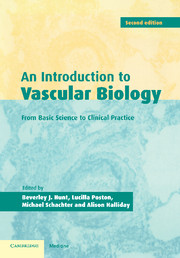Book contents
- Frontmatter
- Contents
- List of contributors
- Preface
- Part I Basic science
- Part II Pathophysiology: mechanisms and imaging
- Part III Clinical practice
- 12 Vascular biology of hypertension
- 13 Atherosclerosis
- 14 Abdominal aortic aneurysm
- 15 The vasculature in diabetes
- 16 The vasculitides
- 17 Pulmonary hypertension
- 18 Role of endothelial cells in transplant rejection
- 19 Vascular function in normal pregnancy and preeclampsia
- Index
18 - Role of endothelial cells in transplant rejection
Published online by Cambridge University Press: 07 September 2009
- Frontmatter
- Contents
- List of contributors
- Preface
- Part I Basic science
- Part II Pathophysiology: mechanisms and imaging
- Part III Clinical practice
- 12 Vascular biology of hypertension
- 13 Atherosclerosis
- 14 Abdominal aortic aneurysm
- 15 The vasculature in diabetes
- 16 The vasculitides
- 17 Pulmonary hypertension
- 18 Role of endothelial cells in transplant rejection
- 19 Vascular function in normal pregnancy and preeclampsia
- Index
Summary
Introduction
Approximately 36 000 transplants are performed throughout the world each year, of which the majority are kidney transplants. About 5000 hearts, 6500 livers and 1200 lung transplants are performed. Rejection remains the most common complication following transplantation and is the major cause of morbidity and mortality. Endothelial cells form the interface between donor tissue and recipient blood and so are the first donor cells to be recognized by the host's immune system. This fact, and the observation that they express numerous molecules able to stimulate lymphocytes, has led to much research into their precise role in transplant rejection. It is our view that endothelial cells are pivotal both in controlling the egress of inflammatory cells into the allografted organ and also as specific antigen-presenting cells (APCs), by presenting foreign molecules to the immune system (Figure 18.1).
Rejection is mediated by both cell-mediated and humoral mechanisms but the relative importance of these pathways differs in acute and chronic rejection. This chapter briefly describes the features of acute and chronic rejection and then outlines the role of endothelial cells in this process.
Basic mechanism of rejection
The major stimulus for rejection of allografted organs is recognition that the donor cells are foreign, by recognition of antigens that are coded by the major histocompatibility complex (MHC). There are two classes of MHC: class I (human leukocyte antigen, HLA) ABC) and class II (HLA-DR, DP, DQ).
- Type
- Chapter
- Information
- An Introduction to Vascular BiologyFrom Basic Science to Clinical Practice, pp. 381 - 397Publisher: Cambridge University PressPrint publication year: 2002
- 1
- Cited by



